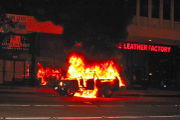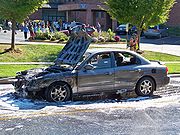
Car fire
Encyclopedia

Conflagration
A conflagration or a blaze is an uncontrolled burning that threatens human life, health, or property. A conflagration can be accidentally begun, naturally caused , or intentionally created . Arson can be accomplished for the purpose of sabotage or diversion, and also can be the consequence of...
(uncontrolled burning) involving a motor vehicle
Motor vehicle
A motor vehicle or road vehicle is a self-propelled wheeled vehicle that does not operate on rails, such as trains or trolleys. The vehicle propulsion is provided by an engine or motor, usually by an internal combustion engine, or an electric motor, or some combination of the two, such as hybrid...
. Also termed car fire or auto fire, it is one of the more common causes of fire
Fire
Fire is the rapid oxidation of a material in the chemical process of combustion, releasing heat, light, and various reaction products. Slower oxidative processes like rusting or digestion are not included by this definition....
-related property damage
Property damage
Property damage is damage to or the destruction of public or private property, caused either by a person who is not its owner or by natural phenomena. Property damage caused by persons is generally categorized by its cause: neglect , and intentional damage...
.
Causes

Motor vehicle
A motor vehicle or road vehicle is a self-propelled wheeled vehicle that does not operate on rails, such as trains or trolleys. The vehicle propulsion is provided by an engine or motor, usually by an internal combustion engine, or an electric motor, or some combination of the two, such as hybrid...
contains many types of flammable materials, including flammable liquids like gasoline
Gasoline
Gasoline , or petrol , is a toxic, translucent, petroleum-derived liquid that is primarily used as a fuel in internal combustion engines. It consists mostly of organic compounds obtained by the fractional distillation of petroleum, enhanced with a variety of additives. Some gasolines also contain...
and oil
Oil
An oil is any substance that is liquid at ambient temperatures and does not mix with water but may mix with other oils and organic solvents. This general definition includes vegetable oils, volatile essential oils, petrochemical oils, and synthetic oils....
as well as solid combustibles such as hose
Hose
A hose is a hollow tube designed to carry fluids from one location to another. Hoses are also sometimes called pipes , or more generally tubing...
. Fuel
Fuel
Fuel is any material that stores energy that can later be extracted to perform mechanical work in a controlled manner. Most fuels used by humans undergo combustion, a redox reaction in which a combustible substance releases energy after it ignites and reacts with the oxygen in the air...
leaks from ruptured fuel line
Fuel line
A fuel line is a hose used to bring fuel from one point in a vehicle to another or from a storage tank to a vehicle. It is commonly made of reinforced rubber to prevent splitting and kinking....
s also can rapidly ignite
Combustion
Combustion or burning is the sequence of exothermic chemical reactions between a fuel and an oxidant accompanied by the production of heat and conversion of chemical species. The release of heat can result in the production of light in the form of either glowing or a flame...
.
Vehicles house multiple potential sources of ignition including electrical devices that may short circuit
Short circuit
A short circuit in an electrical circuit that allows a current to travel along an unintended path, often where essentially no electrical impedance is encountered....
s, hot exhaust system
Exhaust system
An exhaust system is usually tubing used to guide reaction exhaust gases away from a controlled combustion inside an engine or stove. The entire system conveys burnt gases from the engine and includes one or more exhaust pipes...
s, and modern car devices such as air bag detonator
Detonator
A detonator is a device used to trigger an explosive device. Detonators can be chemically, mechanically, or electrically initiated, the latter two being the most common....
s.
Also, car batteries
Car battery
An automotive battery is a type of rechargeable battery that supplies electric energy to an automobile. Usually this refers to an SLI battery to power the starter motor, the lights, and the ignition system of a vehicle’s engine...
pose a fairly unique hazard in themselves: hydrogen
Hydrogen
Hydrogen is the chemical element with atomic number 1. It is represented by the symbol H. With an average atomic weight of , hydrogen is the lightest and most abundant chemical element, constituting roughly 75% of the Universe's chemical elemental mass. Stars in the main sequence are mainly...
gas evolved in the electrolysis
Electrolysis
In chemistry and manufacturing, electrolysis is a method of using a direct electric current to drive an otherwise non-spontaneous chemical reaction...
reaction ignites readily in fire conditions and can result in an explosive dispersion of battery acid.
Electric and hybrid cars have large batteries, usually NiMH, lead-acid, or Li-ion. Besides the obvious hazard of electric shock, these batteries can create other hazards. Li-ion batteries can explode rapidly and in chain reaction. Lead-acid batteries can release hydrogen or melt and leak sulfuric acid. Ni-MH batteries can burn and leak chemicals as well, but their hazards are usually less severe. Most large batteries for electric cars or hybrids have built-in safety features to prevent the battery from starting a fire such as smoke detectors, temperature sensors, and overcharge protection.
In the UK, accidental car fires are declining but deliberate car fires (arson
Arson
Arson is the crime of intentionally or maliciously setting fire to structures or wildland areas. It may be distinguished from other causes such as spontaneous combustion and natural wildfires...
) are increasing. Most car fires are deliberate in the UK. It is common for joyriders to set fire to stolen cars: abandoned cars are commonly set on fire by vandals. Around two cars out every thousand registered in the UK catch fire each year.
It is often the case in non-arson
Arson
Arson is the crime of intentionally or maliciously setting fire to structures or wildland areas. It may be distinguished from other causes such as spontaneous combustion and natural wildfires...
auto fires that the bulk of the fire is (at least initially) contained in the engine compartment of the vehicle. In most vehicles, the passenger compartment is protected from engine compartment fire by a firewall
Firewall (construction)
A firewall is a fireproof barrier used to prevent the spread of fire between or through buildings, structures, electrical substation transformers, or within an aircraft or vehicle.- Applications :...
.
History
While some cases of deliberate car fires are isolated incidents, committed clandestinely, the practice is publicly performed by either rioters and revelers, with little to no retribution. Examples include:2011
- 2011 Vancouver Stanley Cup riot2011 Vancouver Stanley Cup riotThe 2011 Vancouver Stanley Cup riot was a public disturbance that broke out in the downtown core of Vancouver, British Columbia, Canada on Wednesday, June 15, 2011. The riots happened immediately after the conclusion of the Boston Bruins' win over the Vancouver Canucks in game seven of the Stanley...
s, 17 cars set ablaze. - 2011 England riots2011 England riotsBetween 6 and 10 August 2011, several London boroughs and districts of cities and towns across England suffered widespread rioting, looting and arson....
, 12 cars set ablaze
Recommended action

- If the vehicle is moving, politely signal and move to the side of the road.
- Shut off the engine.
- Get yourself and all other occupants out of the vehicle immediately.
- Get far away from the vehicle and stay away from it. Keep onlookers and others away.
- Warn oncoming traffic.
- Notify emergency services.
- Do not attempt to try to put out the fire yourself.
The last is important due to the risk of explosion and the toxic fumes emanating from vehicles fires. Inhalation of toxic fumes is the most common form of fire-related death.
Opening the hood (bonnet) of a car which may be on fire is especially dangerous, as it allows a rapid and significant surge of air into the engine compartment, which may cause a rapid increase in fire intensity. Some countries require the carrying of a fire extinguisher. This should not be seen as overriding the advice above. It has been suggested that, when using a fire extinguisher on an engine fire, the extinguisher should be fully discharged through the gap created by simply releasing (but not lifting) the hood, and then the car should be left until the fire crew have pronounced it safe. As with all fires, residual hot spots may cause the fire to flare up again when fresh oxygen is supplied.

